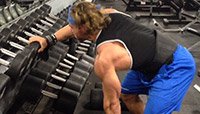Warming up, a phrase loosely thrown around by trainees across the world. Most peoples workout lacks efficiency and produces zero benefits. A proper warm-up can go a long way in increasing the bodies ability to perform. Benefits of warming-up.
- Increase synovial fluid in the joints.
- Raise body temperature.
- Neural arousal.
- Opening of capillaries to muscles.
- Metabolic adjustment to heavy loads.
Let's take a look at the typical trainees warm-up routine. It's Monday and it's chest day for John. John enters the gym and walks straight over to the flat bench. He stands in front of the bench and begins swinging his arms clockwise now counter clockwise, he does a few side bends to the left side then to the right side. He is ready for his warm-up set on bench. He throws 135 on the bar and does 15 reps.
Now he goes straight to his first workset of 225. That is what most warm-ups look like. If you workout regularly in a commercial gym I am sure you have seen this practice. If you happen to be guilty of this practice yourself it is time to change.

A Proper Warm-Up
- A generalized warm-up to raise body temperature.
- Stretching bodyparts that will be worked.
- Specific warm-up to open up neural pathways and pump blood in the targeted muscle.
Do not stretch before you warm-up. I know, in high school you stretched then you ran your laps. This practice is flawed and does little to improve range of motion or enhance performance.
A warm muscle is more flexible than a cold muscle. My favorite analogy to describe this situation is the taffy analogy. Put a piece of taffy in the microwave heat it up and now stretch it. It is obviously more flexible than before you put it in the microwave, because it is warm.
When stretching before the workout use dynamic range of motion stretching (holding stretch 10 seconds) or contract relax stretching (contract muscle then stretch it). Contracting a muscle prior to stretching it allows for increased range of motion.
The specific warm-up refers to performing warm-up sets before the work set. A warm-up set performed like the one above will not enhance performance. There is no need to do so many reps in one warm-up set, as this increases the likelihood of lactic acid buildup.
Jumping from 135 to 225 is a no-no. The nervous system is not ready for this large increase in weight. The the warm-up set above was too heavy for a first warm-up set when using 225 for the work set.
The warm-up sets vary depending on work load. As a general rule more warm-up sets are required for heavier loads. Lighter worksets require fewer warm-up sets. Below I have listed some examples of proper warm-up sets.
Proper Warm-Up Sets
Workset 300 lbs: 5 Reps Warmup Sets
- 95 lbs. 8 reps
- 135 lbs. 4 reps
- 185 lbs. 2 reps
- 225 lbs. 2 reps
- 270 lbs. 1 rep
Workset 250 lbs: 8 Reps Warmup Sets
- 95 lbs. 8 reps
- 135 lbs. 4 reps
- 185 lbs. 2 reps
- 225 lbs. 1 rep
Workset 175 lbs: 15 Reps Warmup Sets
- 80 lbs. 8 reps
- 125 lbs. 4 reps
Workset 400 lbs: 1 Rep Warmup Sets
- 95 lbs. 8 reps
- 135 lbs. 4 reps
- 185 lbs. 2 reps
- 225 lbs. 2 reps
- 270 lbs. 2 reps
- 330 lbs. 1 rep
Recommended For You

Armed Warfare: CT Fletcher's Arms Workout
CT Fletcher knows a thing or fifty about building monstrous biceps and triceps. Think you can hang? Get ready to command your muscles to grow!
Fitstagram Vol. 14: Gym Motivation To Become Your #BESTSELF
Here are 15 Bodybuilding.com athletes showing the world what they do best! Follow these motivational super humans on Instagram.
